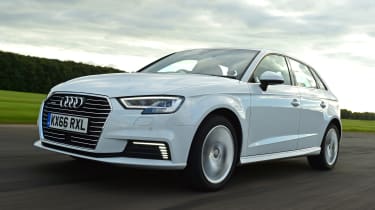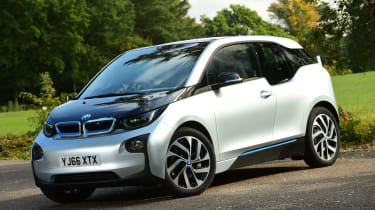BMW i3 vs Audi A3 e-tron
These premium electric cars have both been updated to provide more real-world usability - which is the better buy?
When BMW launched the i3 in 2013, it revolutionised the EV sector. The company’s premium and practical ‘i’ sub-brand forced not only motorists to rethink their approach when it came to electric vehicles, but rival manufacturers, too.
Offered in pure-electric and hybrid Range Extender form, the i3 meant buyers’ consciences were as clean as their cars by offering environmentally friendly motoring that didn’t force owners to sacrifice comfort or style. A raft of hybrids followed the i3, with Audi releasing its A3 e-tron a year later – and now, after a few years on sale, both German brands have chosen to update their respective eco hatches.
• Best low emission green cars
The BMW gets more electric range as a result of a larger 33kWh battery pack, so it’s more usable than ever – particularly the Range Extender model. However, the Audi’s updates are only cosmetic, with few changes to the mechanicals underneath. Read on to find out which approach takes victory.
Head to head
| Model | BMW i3 Range Extender | Audi A3 Sportback e-tron |
| Price | £35,480 | £35,930 |
| Engine | 647cc 2cyl plus electric motor | 1.4-litre 4cyl plus electric motor |
| Power/torque | 168bhp/250Nm | 201bhp/350Nm |
| Transmission | Single-speed auto, rear-wheel drive | Six-speed dual-clutch auto, front-wheel drive |
| 0-60mph | 7.6 seconds | 7.6 seconds |
| Top speed | 93mph | 138mph |
| Test economy | 171.6mpg | 60.4mpg |
| CO2/tax | 12g/km/£0 | 38g/km/£0 |
| Options | Metallic paint (£530), professional media nav (£960), 19-inch wheels (£680), electric glass roof (£780), Harman Kardon hi-fi (£640), LEDs (£710), enhanced Bluetooth (£350), online entertainment (£160) | Metallic paint (£550), interior storage pack (£175), LED cabin lighting pack (£195), folding door mirrors (£200), Audi Parking System Plus (£300) |
BMW i3 Range Extender
To call this new i3 a facelift is something of a misnomer. The car remains unchanged to look at, although there’s still nothing wrong with the futuristic styling. But under the skin sits a new battery with more capacity, which now also has rapid-charging capability as standard.
Used - available now

2020 Audi
A3 e-tron
33,799 milesAutomaticPetrol1.4L
Cash £14,399
2023 Honda
Jazz
34,300 milesAutomaticPetrol1.5L
Cash £15,499
2019 Toyota
Yaris Hybrid
44,333 milesManualPetrol1.5L
Cash £10,990
2026 Toyota
C-HR
2,668 milesAutomaticPetrol1.8L
Cash £24,351While the previous car’s 22kWh unit has been upgraded to 33kWh, the physical size of the battery pack is unchanged, so there’s no compromise when it comes to packaging. The benefit is that, with more usable energy from the battery, the i3’s claimed range increases by more then 50 per cent, so it now stands at 150 miles. However, BMW does state the ‘real world’ range is more like 125 miles, which fits with what we achieved on test.
With a nine-litre fuel tank to feed the 647cc two-cylinder petrol engine sourced from BMW’s motorcycle range, this increases to a maximum of 206 miles, giving you a back-up to rely on if you run out of ‘clean’ propulsion.
While the battery offers more energy, as it hasn’t changed size it still sits in a void in the floor under the i3’s passenger compartment, made possible by the BMW’s clever carbon-fibre structure. But like a regular car’s engine, the i3’s lithium-ion battery pack makes up a significant proportion of the car’s 1,440kg kerbweight. The carbon structure – which is 50 per cent lighter than steel – helps to keep weight down and therefore maximise energy use. The platform also gives a low centre of gravity and a perfect 50:50 weight distribution, according to its maker, so the i3 drives like you’d expect a BMW to.
It’s nice to know it does, but the updated car is about so much more than that. Rapid charging is now standard, so it’ll give you an 80 per cent charge in around 40 minutes, while BMW’s i wallbox will do the same in around four hours. Charge from a three-pin plug and this will take around 10 hours, which is manageable if you do it overnight.
This is better than the Audi can manage, as the e-tron’s 8.8kWh battery doesn’t have the same charging capacity. This means it’ll take around two hours 15 minutes for a full charge using its fastest-possible method, while a standard home socket will top it up in around three hours. Together with the A3’s 29-mile electric range, this highlights the e-tron isn’t quite as sophisticated as the i3.
This is partly reflected in the styling, too, as the i3’s unusual design highlights its alternative propulsion. Plenty of blue accents point towards this being an efficient model, while the e-tron merely looks like a regular A3.
- • For: Beautifully designed and built interior, efficiency, relaxing to drive
- • Against: Strict four-seater, still relatively expensive to buy, firm ride
Audi A3 e-tron
Audi is part of the VW Group, and it uses the automotive giant’s MQB, front-wheel-drive chassis. This versatile, modular set-up was designed to house hybrid powertrains from the start. This means the e-tron has always been in Audi’s product plan for the current A3, so there aren’t too many drawbacks to housing a conventional petrol unit up front, a big battery pack in the rear, and an electric motor sandwiched in between the engine and gearbox.
That powerplant is Audi’s turbocharged 148bhp 1.4-litre TFSI petrol, which uses cylinder-deactivation technology to further boost the unit’s efficiency. But combined with the electric motor – which can provide 101bhp and 330Nm of torque on its own – the total system output stands at 201bhp and 350Nm of torque.
This is quite a lot in a not especially sporty family hatch, but the weight of the battery pack – the e-tron tips the scales at 1,540kg in total – dulls the performance, so the more powerful Audi only equalled the i3’s 7.6-second 0-60mph time on test.
However, due to the i3’s instant torque and single-speed electric motor, the A3 was four-tenths slower over our benchmark test from 30 to 70mph, accelerating through the gears in 7.1 seconds.
This is where the Audi’s biggest flaw lies, as the electric motor only supplements the petrol engine. It’s also not especially easy to keep the car running on electric power alone, which hurts efficiency, while the regenerative braking isn’t as effective in recharging the battery on the move.
However, there’s more to the e-tron than its powertrain. Mildly tweaked looks haven’t changed the car’s sharp shape, and even sitting next to the futuristic i3 it looks like a premium rival.
The story is the same inside. The cabin is not as unusual as its BMW counterpart’s in terms of its layout or materials, but it offers an upmarket haven of soft, high-quality plastics, and minimalist design. Its equipment tally is good, too, with sat-nav, DAB, Bluetooth, sports seats, LED headlights with high-beam assist, cruise control and parking sensors all standard.
However, there’s one important change to this facelifted e-tron compared with its predecessor. Audi has done away with the hybrid charge mode, which used the engine to force-charge the battery. The manufacturer says this put greater load on the TFSI powerplant, increasing fuel consumption, so now the only way to recharge the battery pack on the move is by using the brakes – and even then, the system is not as effective as that of the i3.
- • For: Drives like the regular A3, low CO2 means low BiK for business users, flexibility
- • Against: Smaller boot than normal A3, limited electric range, dull if high-quality cabin
Verdict
First place: BMW i3
The i3 was designed from the ground up as an eco car, and so feels less compromised than the A3, which accommodates more conventional powertrains. The BMW is a relaxing, strong performer. More importantly, it mixes incredible efficiency with quality and a greater sense of individuality than the Audi.
Second place: Audi A3 e-tron
Both cars need plugging in to maximise their efficiency, but the e-tron still can’t match the i3’s economy. Little splits them on price, and the BMW is just as practical and will cost less to run, saving £670 per year in fuel. The A3 simply isn’t as versatile, relying on its engine more and taking longer to charge.









